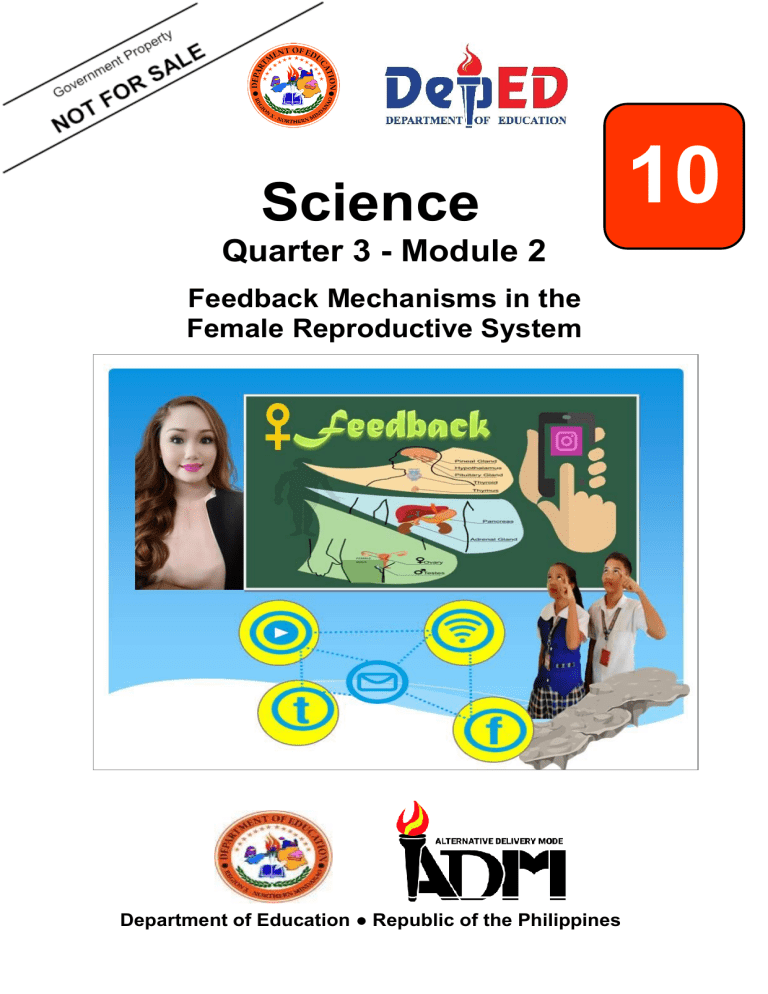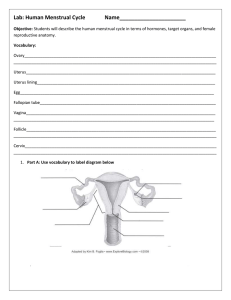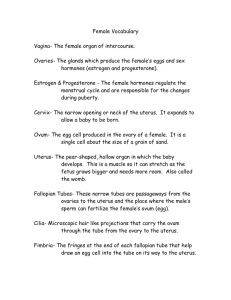
Science Quarter 3 - Module 2 Feedback Mechanisms in the Female Reproductive System Department of Education ● Republic of the Philippines 10 Science- Grade 10 Alternative Delivery Mode Quarter 3 – Module 2: Feedback Mechanisms in the Female Reproductive System First Edition, 2020 Republic Act 8293, section 176 states that: No copyright shall subsist in any work of the Government of the Philippines. However, prior approval of the government agency or office wherein the work is created shall be necessary for exploitation of such work for profit. Such agency or office may, among other things, impose as a condition the payment of royalty. Borrowed materials (i.e., songs, stories, poems, pictures, photos, brand names, trademarks, etc.) included in this book are owned by their respective copyright holders. Every effort has been exerted to locate and seek permission to use these materials from their respective copyright owners. The publisher and authors do not represent nor claim ownership over them. Published by the Department of Education – Division of Bukidnon Schools Division Superintendent: Dr. Randolph B. Tortola, CESO V Development Team of the Module Author/s Content Editor Language Editor Reviewers Illustrator and Layout Artist Management Team Chairperson Co-Chairpersons Members : : : : : Crystal Jade S. Mongas Loniel D. Barro, PhD Maria Luisa M. Casiño Ellen A. Azuelo, PhD, Rejynne Mary L. Ruiz, PhD Crystal Jade S. Mongas : Arturo B. Bayocot, PhD, CESO III Regional Director : Victor G. De Gracia Jr., PhD, CESO V Assistant Regional Director : Randolph B. Tortola, PhD, CESO IV Schools Division Superintendent : Shambaeh A. Abantas-Usman, PhD Assistant Schools Division Superintendent : Mala Epra B. Magnaong, Chief ES, CLMD : Neil A. Improgo, EPS-LRMS Bienvenido U. Tagolimot, Jr., EPS-ADM Elbert R. Francisco, CID Chief Ellen A. Azuelo, EPS-Science Rejynne Mary L. Ruiz, LRMDS Manager Jeny B. Timbal, PDO II Shella O. Bolasco, Librarian II Printed in the Philippines by Department of Education – Division of Bukidnon Office Address: Sumpong, Malaybalay City Telephone: (088) 813-3634 E-mail Address: bukidnon@deped.gov.ph Lesson 1 The Menstrual Cycle What’s New WHAT’S THE WORD? Direction: Observe the four pictures and solve the puzzle by working out what the word is. Every box corresponds to a certain letter. Write your answer in a separate sheet of paper. Figure 1.1 What’s the word model Source: www.google.com Images Labeled for Reuse This process only occurs among females. It is a normal vaginal bleeding that occurs as part of a female’s monthly cycle which is known as menstruation. What Is It We have previously discussed that an ovary normally releases only one egg every 28 days. What controls the timing are the hormones. Hormones control many of the changes in the reproductive system. They also coordinate the development of the ovum and the uterus. Remember that hormones are chemicals that can affect certain body organs. This cycle among females occurs every month starting when a female is 10 to 13 years old and it continues for about 40 years. If an ovum is not fertilized in the fallopian tube, the corpus luteum degenerates, the progesterone production stops, and the inside membrane of the uterus breaks down. The breakdown and discharge of the soft uterine tissues and the fertilized egg is called menstruation. This is the monthly changes or periods that take place in the female reproductive system. 3 1 The Menstrual Cycle The female sex hormones control the secondary sex characteristics as well as the ovarian and uterine cycle. Like males, females also secrete follicle stimulating hormone (FSH) and luteinizing hormone (LH) as directed by the pituitary gland during puberty. This signals the start of puberty which includes the development of the secondary sex characteristics in females and the onset of menstruation. A female experiences body changes even before the first menstruation which is also known as menarche. The female secondary sex characteristics include the development of the breast; growth of underarm and pubic hair; rounded body shapes brought about by a widespread layer of fat in areas like the abdomen, hips and thighs; widening of the hips in preparation for childbirth; and the development of higher pitched voice. At puberty, the master gland which is the pituitary gland starts a series of hormonal changes that make a woman capable of pregnancy. These hormonal changes and the effects they produce is called the menstrual cycle. While the length of this cycle varies, the typical cycle is about 28 days. During this process, changes in both the ovary and the uterus take place. The Ovarian Cycle At the start of the cycle, the pituitary gland secretes increased amount of FSH and this allows an ovarian follicle to mature. The female sex hormone called estrogen, is also secreted as the follicle cells develop. When the follicle cells multiply, the cells signal an increased level of estrogen in the blood, and the pituitary gland secretes another hormone, the luteinizing hormone (LH). LH and FSH bring about the maturation of the follicle which results to ovulation -the releasing of the mature egg. Ovulation usually occurs on the 14th day of the cycle. During ovulation, the egg is ready for fertilization within 24 hours from its release. Still under the influence of LH, the cells of the ruptured follicle develop into a Figure 1.2 The ovary (Source: www.google.com Labeled for Reuse) yellow body called the corpus luteum. The yellow body then produces more estrogen and another female sex hormone called the progesterone. Both hormones prepare the uterine wall for the possible implantation of a fertilized egg. The rise in the level of estrogen and progesterone exerts a feedback control over the pituitary gland to inhibit the secretion of LH and FSH. The corpus luteum is deprived of the hormones that maintain it with the drop in the amount of these two hormones, hence the corpus luteum begins to degenerate. Thus, the gland’s influence on the progesterone level will affect the endometrial wall in a domino effect. The Uterine Cycle A series of changes also happens in the uterus as a consequence of the hormones while events are taking place in the female’s ovary. With the low levels of progesterone, the surface of the endometrium or wall begins to disintegrate and the blood vessels rupture. Blood and some accompanying endometrial tissues flow out of the vagina in a process called menstruation. This menstrual phase lasts for about five days. 24 The Uterine Cycle A series of changes also happens in the uterus as a consequence of the hormones while events are taking place in the female’s ovary. With the low levels Figure 1.3 The ovarian and uterine cycle(Source: www.google.com Labeled for Reuse) of progesterone, the surface of the endometrium or wall begins to disintegrate and the blood vessels rupture. Blood and some accompanying endometrial tissues flow out of the vagina in a process called menstruation. This menstrual phase lasts for about five days. After the menstrual period, the endometrium starts to build up due to the increasing amount of estrogen by the developing follicles in the ovary. This is the proliferative phase of the uterine cycle which lasts for 6 to 14 days. The formation of the corpus luteum and the secretion of progesterone trigger the endometrium to double in thickness and prepare itself for a developing embryo. The uterine glands also become mature and they produce a thick secretion. Hence, the secretory phase of the uterine cycle begins on the 15 th day until before the onset of the next menstrual phase. However, this cycle may be interrupted by stress, health concerns and pregnancy. But if pregnancy does not occur, the cycle begins anew. What’s More ACTIVITY: CAN YOU DESCRIBE ME? In this activity, you will describe how menstruation occurs in the female reproductive system. Direction: Study the diagram below to describe how menstruation occurs and answer the guide questions that follow. Figure 1.4 The phases/cycles (Source: www.google.com Labeled for Reuse) 35 Guide Questions 1. Record your observations on the table below. Phases Hormones Involved 2. How does the menstrual cycle occur in females? _____________________________________________________________ _____________________________________________________________ Remember, hormones coordinate the development of the ovum and the uterus. Lesson 2 Hormone Feedback and Menstruation What’s New Menarche is the most obvious signal of the onset of puberty in females. This is the first menstrual discharge of blood from the vagina. Menarche also signals the beginning of cyclic changes in the ovary. Oocytes that were unripe or untouched are now brought up to become active. Thus, every month, an ovarian cycle takes place. Figure 2.1 shows the changes in the lining of the uterus as the month progresses. Before moving on, let us Figure 2.1 Changes in the uterine lining first try an activity. In this (Source: www.google.com Labeled for Reuse) activity, you are expected to compare the changes that occur during the menstrual cycle. Try to figure out what occurs in its every stage. Direction: Complete the table below by comparing the changes that occur during the menstrual cycle. Part Event Blood Flow Follicular Ovulation Luteal Menstruation occurs. The follicles are formed in the ovary. The oocytes burst from the ovary. The corpus luteum is formed. 46 Number of Days 5 Hormone Produced What Is It The human ovaries can usually produce only one egg during a 28-day cycle of activity. The mass of ovarian cells produces an ovum or an egg and it also forms a follicle. The cycle is controlled by FSH or the FollicleStimulating Hormone. This hormone is produced in the anterior lobe of the pituitary gland. The follicle becomes filled with a fluid containing the hormone estrogen when the egg reaches maturity. Figure 2.2 A cross section of the ovary Most importantly, the rising level of FSH stimulates follicle maturation and estrogen production. Figure 2.2 shows the cross section of a human ovary with different stages of development. As the cycle continues and after the ovum has been discharged, the follicle turns yellow and it forms the corpus luteum. The yellow body formation is controlled by another hormone of the pituitary gland called the LH or luteinizing hormone. The corpus luteum then produces another hormone known as progesterone. Progesterone brings about effects in the secondary characteristics primarily on the breasts. During pregnancy, progesterone causes breast enlargement. Moreover, this hormone maintains the growth of the mucus lining of the uterus. To summarize, the important female hormones are as follows: Female Hormone Estrogen Location Follicles/Ovary Progesterone Corpus Luteum/Ovary LH Pituitary Gland FSH Pituitary Gland Function Responsible for secondary female characteristics; thickens endometrium; inhibits growth of facial hair Stimulates endometrium; inhibits uterine contractions and ovulation Develops and maintains the corpus luteum; stimulates ovulation Stimulates the formation of follicles in the ovaries Have you experienced menstrual cramps? Probably yes, you have. In reality, some females experience menstrual cramps every month. Did you know that menstrual cramps are the results of the strong contractions of the uterine wall that occur before and during menstruation? What do you think is its cause? Cramps can be caused by the excessive secretion of prostaglandins. Shedding of the endometrium of the uterus results in the inflammation of the endometrial layer. As a consequence of this inflammation, prostaglandins are produced. In a nutshell, the following summarizes the important events during the menstrual cycle: 1. The pituitary gland begins the cycle. 2. The pituitary releases hormones that cause the egg in the ovary to mature. The luteinizing hormone (LH) initiates the maturation of the follicles, converts ruptured follicle into the corpus luteum and cause the secretion of 75 progesterone. The other hormone, follicle stimulating hormone (FSH) assists in the maturation of the follicles and cause the secretion of estrogen from the follicles. 3. Meanwhile, the ovary itself releases a hormone called estrogen. Estrogen is a hormone that causes changes in the female reproductive system. This hormone also causes the uterus to increase in thickness. The uterus becomes thicker so that the fertilized egg can attach to it. 4. 5. 6. 7. 8. The ovary releases an egg on day 14. Now, assume that no sperm was present. The egg moves through the oviduct and enters the uterus. At the same time, the uterus continues to thicken. The egg has not been fertilized, therefore, it will not attach to the uterus. The thick uterus is no longer necessary, so it begins to break apart. The cells of the thickened uterus break off and leave the vagina. The unfertilized egg is also lost. Some blood is lost, too. This loss of cells from the uterus lining, blood and egg is called menstruation. 9. After menstruation, the cycle starts again. What is a feedback mechanism? A feedback mechanism is the process through which the level of a certain substance influences the level of another substance. A negative feedback affects the production of hormones in the menstrual cycle. Moreover, high levels of one hormone may inhibit the production of another hormone. Figure 2.3 presents the negative feedback mechanisms in the menstrual cycle. Based on the figure, Figure 2.3 Negative feedback mechanisms in the menstrual cycle follicle stimulating hormone or FSH stimulates the ovaries to release estrogen. High levels of estrogen then prevent more production of FSH. Estrogen then stimulates the release of luteinizing hormone or LH from the pituitary gland, which in turn, controls the production of progesterone. Moreover, high levels of progesterone can then inhibit the further release of LH. 86 What’s More ACTIVITY 1: CAN YOU JUSTIFY ME? Objective Determine the hormones involved in regulating the processes in the female reproductive system Procedure Check “Yes” if the hormone is involved in regulating the given process, otherwise check “No”. If your answer is “No”, please state the reason behind it. Write your answers in the table. Hormone Yes No Reason 1. Adrenocorticotropic 2. Estrogen 3. Antidiuretic Hormone 4. Progesterone 5. Parathyroid Hormone 6. Luteinizing Hormone 7. Epinephrine 8. Follicle Stimulating Hormone 9. Testosterone 10. Melatonin Activity 2 A. Study the given pictures to describe the feedback mechanisms involved during the menstrual cycle and answer briefly the guide questions below. A B Source: www.google.com Images Labeled for Reuse 9 97 Guide Questions 1. How long does a menstrual cycle usually last if fertilization has not taken place? 2. Describe what happens to the egg during the first 14 days of the cycle in Part B. 3. Describe what happens to the egg and the uterus during the last 14 days of the cycle in Part A. 4. What takes place after fertilization? Hormone Feedback and Pregnancy Lesson 3 What’s New Now that you have already known about the parts and functions of the human reproductive system, let us now trace what happens to the ovulated egg to its orderly sequence of events from the time an egg is ovulated. In this activity, you should be able to arrange the sequence from the beginning to the end of fertilization and implantation in the uterus. Direction: Complete the table below by sequencing the events from the time an egg is ovulated. Arrange orderly by numbering the items from 1 to 7. Write your answer inside the table. Event Sequence Fertilized egg attaches to the uterus Fertilized egg moves out of the oviduct Egg is fertilized in the oviduct Vagina receives the sperm Egg moves into the oviduct Egg is released from the ovary Egg is in the ovary What Is It A zygote or a fertilized egg is formed when a sperm successfully penetrates the nuclei fuse. A fertilization membrane develops to prevent other sperms to further penetrate the egg. This process wherein the sperms’ nucleus and the ovum’s unite is called fertilization. It usually takes place while the egg is traveling along the oviduct or fallopian tube. It will take about 7 to 10 days for an egg, fertilized or not, to reach the uterus. Figure 3.1 The zygote Source: www.google.com Image Labeled for Reuse 108 Upon successful implantation of a developing embryo in the endometrium, the developing embryo and the uterine lining jointly form a special organ called the placenta. This will provide nourishment for the embryo. It also secretes the hormone called human chorionic gonadotropin (HCG), which is related to LH since they act on the same receptor. Remember that the LH maintains the corpus luteum. With the corpus luteum intact, progesterone production is maintained and the uterine wall will not menstruate. HCG actually passes in the urine. It is the same hormone detected in pregnancy tests. If the embryo is abnormal or if it dies, HCG will drop and the endometrium will disintegrate causing a woman to have a miscarriage. As your guide, refer below for the summary of the stages of reproduction: Figure 3.2 Pregnancy test Source: www.google.com Image Labeled for Reuse 1. Egg cells are formed in each ovary. 2. Each month, one ovary releases an egg. Normally, only one egg is released about every 28 days. The ovaries usually take turns in releasing the eggs. 3. Once released from the ovary, the egg moves into a tube called oviduct. Oviducts are tube-like organs that connect the ovaries to the uterus. The uterus is a muscular organ in which the fertilized egg develops. 4. Sperm cells are released into the vagina during mating. The vagina is a muscular tube that leads from the outside of the female’s body to the uterus. Sperm cells swim from the vagina into the uterus and into the oviducts. If an egg is present, fertilization takes place. Once fertilized, the egg moves down the oviduct into the uterus. 5. The fertilized egg then attaches itself into the wall of the uterus which is called implantation. Once attached, it will remain there for nine months as it develops into a baby. Figure 3.3 A human embryo Source: www.google.com Image Labeled for Reuse What is ectopic pregnancy? Ectopic pregnancy results if implantation occurs anywhere other than the uterine cavity. The most common site of ectopic pregnancy is in the fallopian tube. Implantation in the fallopian tube can be fatal and can cause the tube to rupture. In some cases, implantation can occur in the mesenteries of the abdominal cavity and the fetus can develop normally, but must be delivered by caesarian section. Figure 3.4 A cross section of the ovary Source: www.google.com Image Labeled for Reuse 119 As a summary, outlined below are the different processes involved during pregnancy. Ovulation This refers to the release of a mature egg from the ovary. It usually takes place on the 14th day from the first day of menstruation if the cycle is a 28-day cycle. Fertilization When a sperm encounters an egg cell in the fallopian tube, it releases digestive enzymes. Those enzymes clear the path for the sperm nucleus to fuse with the nucleus of the ovum or egg cell. A zygote is now formed. Implantation This occurs before the end of the first week. By this process, the zygote attaches to the uterine lining, and some of its cells send out projections that has been part of the maternal tissue. The inner cell mass becomes the embryonic disc. This disc will give rise to the embryo proper during the week following implantation. Birth or Parturition “Happy birthday!” is a very common greeting to mark the anniversary of a person’s birth. Birth takes place about 39 weeks after fertilization. The birth process begins when the uterus starts to contract. For the next two to eighteen hours, the contraction becomes stronger and more frequent. The cervical canal dilates fully and the amniotic sac ruptures. Birth typically occurs less than an hour after full dilation. Immediately afterward, uterine contraction forces fluid, blood and the placenta out of the body. The umbilical cord is now cut, and the newborn embarks on its nurtured existence in the outside world. What’s More ACTIVITY: A-MAZE-ING EGG RACE! Objective Trace the processes involved during the release of an egg and fertilization Procedure Shade the arrow that correctly traces the processes involved during the release of an egg. Your answers will guide you to the end of the maze. 12 10 Assessment (Unit Test) Direction: Choose the CAPITAL LETTER of the best answer. Write the chosen letter on a separate sheet of paper. 1. Which days of the cycle does menstruation occur? A. days 1-6 B. days 7-13 C. days 14-20 D. days 21-28 2. A biologist made a hypothesis that the pituitary and the ovary both influence the uterine cycle in females, which of the following observation would best support this hypothesis? A. The removal of pituitary is followed by death. B. The removal of the ovary can greatly affect the menstrual cycle. C. The removal of the ovary is followed by a non-functioning pituitary. D. The uterine development takes place only when both pituitary and ovary are present. 3. A woman’s unsafe period is the day near or during _________. A. fertilization B. menstruation C. ovulation D. sexual intercourse 4. In a typical 28-day menstrual cycle, on which day following the beginning of the menstrual period is the level of luteinizing hormone most likely to be the highest? A. day 7 B. day 14 C. day 21 D. day 28 5. What happens during ovulation? A. A sperm can fertilize an egg. B. A zygote becomes an embryo. C. An ovum is released from the ovary. D. A follicle releases the hormone FSH. 6. It is the process through which the level of a certain substance influences the level of another substance? A. FSH B. LH C. menstruation D. feedback 7. An increase in FSH may also indicate a reduction in the production of good quality eggs and embryos for _________. A. fertilization B. menstruation C. ovulation D. all of the choices 8. It is an abnormally high levels of LH during non-ovulatory times in the menstrual cycle. A. menarche B. menopause C. LH D. FSH 9. What signals the beginning of cyclic changes in the ovary? A. menarche B. menopause C. LH D. FSH 10. Which of the following is produced by the mass of ovarian cells? A. sperm B. ovum C. LH D. FSH 11. Where are the sperm cells released during mating? A. ovaries B. uterus C. fallopian tube D. vagina 12. What does the ovary release every month? A. egg B. sperm C. LH D. FSH 13. If the embryo is abnormal or if it dies, _______ will drop. A. HCG B. LH C. FSH D. all of the choices 14. What results to the disintegration of the endometrium? A. menarche B. menopause C. menstruation D. miscarriage 15. Which of the following is the most common site of ectopic pregnancy? A. ovaries B. fallopian tube C. uterus D. vagina 13 11 Answer Key Lesson 1 What’s New MENSTRUATION What’s More ACTIVITY: CAN YOU DESCRIBE ME? 1. Follicular Phase - Estrogen Luteal Phase - Estrogen and Progesterone 2. The egg travels through a thin tube called fallopian tube. If the egg is fertilized by a sperm it attaches itself to the wall of the uterus, where over time, develops into a baby. If the egg is not fertilized, the uterus lining breaks down and bleeds causing menstrual flow. Lesson 2 What’s New 1. Blood flow – none 2. Follicular – Estrogen 3. Ovulation – None 4. Luteal – Estrogen and Progesterone What’s More ACTIVITY 1: CAN YOU JUSTIFY ME? 1. No – synthesis of sex steroids 2. Yes 3. No – increase water absorption 4. Yes 5. No – stimulates calcium uptake 6. Yes 7. No – increases heart rate and blood sugar 8. Yes 9. No – male development 10. No- blocks secretion of LH and FSH, promotes sleep Activity 2 1. 28 days 2. It moves out of the uterus 3. The egg is fertilized and attaches to the uterus for implantation. 4. Implantation Lesson 3 What’s New What’s More ACTIVITY: A-MAZE-ING EGG RACE! Assessment 1. D 11. D 2. B 12. A 3. C 13. A 4. B 14. D 5. A 15. B 6. D 7. A 14 12 8. B 9. A 10. B






